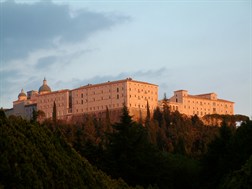The work of Fanzago outside of Naples
 Although Fanzago has resided for a large part of his life in Naples, where he returned after the Masaniello revolt and where he died in 1678, he left his artistic mark even outside the confines of the capital city of Naples. In Andria, for example, he designed the second church, called the “superior”, which was added to the first church, called “The Crucifixion”, the Basilica of the Madonna dei miracoli (Our Lady of Miracles). Between 1626 and 1631 he lived and worked on several occasions in the abbey of Montecassino (picture), later moved to the north for a variety of commissions, including the high altar of the Church of San Nicola al Lido (Saint Nicholas at the Lido) in Venice and the project for the church of Sant’Agata dei Teatini (Saint Agatha of the Theatines) in Bergamo. His presence is also attested to in Abruzzo, in the church of Gesù e Maria (Jesus and Mary) at Pescocostanzo, and even outside the confines of the Italian peninsula. In 1636, the then Viceroy of Naples, Manuel de Zúñiga y Fonseca, Count of Monterrey, commissioned him to design the gate and the pulpit of the Augustinian nuns’ church in Salamanca. The monastery, located in front of the palace of Monterrey, served to accommodate to the viceroy’s daughter, Inés Francisca de la Visitación, who was the first prioress of the convent. The design of the church, which was intended as a burial place for the Earl and his family, had been entrusted, three years before, to Bartolomeo PicchiattiBartolomeo Picchiatti (1571-1643) was a prominent architect who left his mark in many corners of Naples. A native of Ferrara, he lived most of his life and died in Naples. Among his pupils was his son, Francesco Antonio.. Fanzago worked at the church in 1636, also providing the design for the doors. The entire structure was, however, completed only in 1687.
Although Fanzago has resided for a large part of his life in Naples, where he returned after the Masaniello revolt and where he died in 1678, he left his artistic mark even outside the confines of the capital city of Naples. In Andria, for example, he designed the second church, called the “superior”, which was added to the first church, called “The Crucifixion”, the Basilica of the Madonna dei miracoli (Our Lady of Miracles). Between 1626 and 1631 he lived and worked on several occasions in the abbey of Montecassino (picture), later moved to the north for a variety of commissions, including the high altar of the Church of San Nicola al Lido (Saint Nicholas at the Lido) in Venice and the project for the church of Sant’Agata dei Teatini (Saint Agatha of the Theatines) in Bergamo. His presence is also attested to in Abruzzo, in the church of Gesù e Maria (Jesus and Mary) at Pescocostanzo, and even outside the confines of the Italian peninsula. In 1636, the then Viceroy of Naples, Manuel de Zúñiga y Fonseca, Count of Monterrey, commissioned him to design the gate and the pulpit of the Augustinian nuns’ church in Salamanca. The monastery, located in front of the palace of Monterrey, served to accommodate to the viceroy’s daughter, Inés Francisca de la Visitación, who was the first prioress of the convent. The design of the church, which was intended as a burial place for the Earl and his family, had been entrusted, three years before, to Bartolomeo PicchiattiBartolomeo Picchiatti (1571-1643) was a prominent architect who left his mark in many corners of Naples. A native of Ferrara, he lived most of his life and died in Naples. Among his pupils was his son, Francesco Antonio.. Fanzago worked at the church in 1636, also providing the design for the doors. The entire structure was, however, completed only in 1687.
